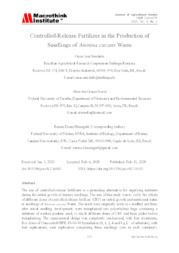Controlled-Release Fertilizer in the Production of Seedlings of Anonna cacans Warm.
Controlled-Release Fertilizer in the Production of Seedlings of Anonna cacans Warm.
Author(s): SMIDERLE, O. J.; SOUZA, A. das G.; MENEGATTI, R. D.
Summary: The use of controlled-release fertilizers is a promising alternative for supplying nutrients during the initial growth of nursery seedlings. The aim of this study was to verify the effects of different doses of controlled-release fertilizer (CRF) on initial growth and nutritional status in seedlings of Anonna cacans Warm. The seeds were originally sown in a seedbed and then, after initial seedling development, were transplanted into polyethylene bags containing a substrate of washed medium sand, to which different doses of CRF had been added before transplanting. The experimental design was completely randomised, with four treatments, five doses of Osmocote® NPK 19-06-10 formulation (0, 1, 2, 4 and 8 g L-1 of substrate), with four replications, each replication comprising three seedlings (one in each container) Increases in root-collar diameter and plant height were determined throughout the experimental period (6 months) from data collected every 30 days after transplanting. At the end of the experiment the following were evaluated: height, root-collar diameter, N concentration, chlorophyll index, chlorophyll concentration (a, b and total) and leaf area. Root-collar diameter and height showed a positive linear response to increases in the fertilizer dose. From a 4 g L-1 dose of CRF, the nutrient supply added to the substrate of medium sand optimises the initial phase of plant growth and guarantees the adequate nutritional status of Anonna cacans, and can be suggested as a viable technique for use in forest nurseries, and one which results in efficient use of the input material and avoids fertilizer wastage.
Publication year: 2020
Types of publication: Journal article
Unit: Embrapa Roraima
Keywords: Araticum-cagão, Osmocote®, Photosynthetic pigments, Plant nutrition
Observation
Some of Embrapa's publications are published as ePub files. To read them, use or download one of the following free software options to your computer or mobile device. Android: Google Play Books; IOS: iBooks; Windows and Linux: Calibre.
Access other publications
Access the Agricultural Research Database (BDPA) to consult Embrapa's full library collection and records.
Visit Embrapa Bookstore to purchase books and other publications sold by Embrapa.

